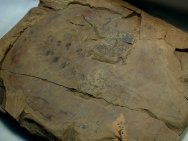Kuamaia lata
Phylum Arthropoda
Geological Time: Early Cambrian (~525 million years ago)
Size: 150 mm long and 110 mm across
Fossil Site: Chengjiang Maotianshan Shales - Quiongzhusi Section, Yu’anshan Member, Heilinpu Formation, Mafang Village, Anning, Kunming, Yunnan Province, China
|
With
the discovery of the Chengjiang Biota in 1984 a window on the Cambrain
Explosion in China was opened. The diversity of soft-tissue fossils
is astonishing: algae, medusiforms, sponges, priapulids, annelid
like worms, echinoderms, arthropods (including trilobites), hemichordates,
chordates, and the first agnathan fish make up The taxon has a relatively wide and flat dorsal exoskeleton (hence the generic name) which is differentiated into a cephalic shield (CS), a thorax (T1-T8), and a pygidium (Py). Note also the eyes, hypostome (H), and central gut as highlighted in the interpretive drawing. It bears some resemblance to the younger Burgess Shale genus Hemetia, which has led some to place them in the Helmetidae along with several other similar arthropods. The body shape suggests that Kuamaia was a benthic animal which was possibly carnivorous. The species is only known from the Chengjiang Biota. |








